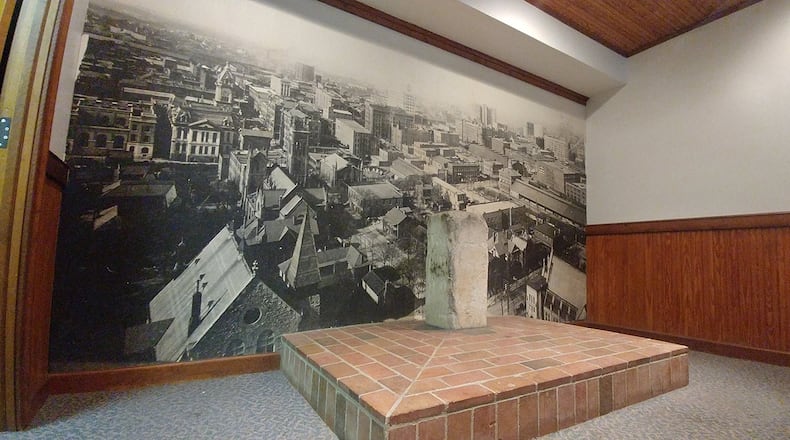The Zero Mile Post, which has marked Atlanta's center since 1850, could be moved within a year to create better access to a parking deck.
Local preservationists are exasperated.
“That would show you what our priorities are in this city,” said Boyd Coons, executive director of the Atlanta Preservation Center.
» Why is construction happening around the Zero Mile Post?
The Georgia Building Authority, which plans to demolish the building that houses the post, is looking for a new home for the landmark that would make the Zero Mile Post more accessible to the public.
But for some preservationists, a historic place marker should stay in the place it marks.
“The significance of the location and the artifact itself are connected,” said Kyle Kessler, an architect and past president of the Atlanta Downtown Neighborhood Association. “Any move … would result in a loss of integrity.”
Darin Givens, co-founder of the urbanist advocacy group ThreadATL, agreed. Rather than find a more accessible home for the post, Givens said it would be better to “keep the milepost in the space where it’s stood since 1850 and make that a more accessible place.”
Coons said the area surrounding the Zero Mile Post has been on his group's endangered list for some time. Too often, he said, state agencies destroy a site, place a historical marker there and call it a day.
Downtown’s entire street grid grew around the city’s rail connections, Coons said, and “the Zero Mile Post is at the center of all that. It’s the city’s central anchor.”
Sheffield Hale, president and CEO of the Atlanta History Center, said he understands the sentiment to keep the post in its original space but said, “This is an artifact that needs to be protected inside.” Hale observed that in Europe, it’s a common practice to place a fragile statue inside a museum and to place a replica in its original position outside.
Although the history center has had no conversations with the agencies handling the post, Hale said his museum would be an ideal place to preserve the original.
“We are the custodians of the city’s history,” he said. “We’re a logical place to put it. The Texas locomotive is here. The Solomon Luckie lamppost is here. They would all be within close proximity to each other.” Plus, he noted, the museum already has a replica of the post that could be swapped with the original.
Hale stressed: "We're not out trying to grab anything," but he noted that the recent installation of the Texas locomotive at the history center spurred some wishful thinking that the museum one day might house the Zero Mile Post. The Texas was one of the engines used on the Western & Atlantic line during Atlanta's early days—the same rail line that the post marks.
The Zero Mile Post is currently housed in a vacant 1980s-era building beneath downtown’s Central Avenue bridge.
The Georgia Building Authority, which owns the building, said its demolition would create better access to the 90 Central Avenue parking deck while two downtown bridges are being replaced. The building currently blocks one of the deck’s entrance/exit ramps.
Luther Lewis, the executive director of the GBA from 1989-99, remembers the construction of the building, which was used as a passenger depot for a tourist rail line for 10 years. “I’m surprised it’s still there,” he said.
The building was carefully constructed around the historic post. “We made a museum and put in a number of railroad displays down there so people would have something to look at while waiting for the train.”
Lewis said that closing off the neighboring parking deck’s ramp was deliberate. “We closed that deck off so that people could walk down to the train. No one ever used [the ramp] anyway.”
As for what happens to the Zero Mile Post, Lewis said, “I think it’d be a shame to move it.”
The post is a short granite column that marks the terminus of the first rail line built here (hence our city’s first name, Terminus). The post later marked the point from which the city boundaries were drawn.
» Ten things that were here before Atlanta
The replacement of the bridges is one of the projects covered by the Renew Atlanta T-SPLOST that was approved by voters in 2015.
In a statement to the AJC, GBA spokespeople said that protection and preservation of the post are top priorities but wouldn’t guarantee that the post’s original position will remain when the construction at the site is complete.
Five local, state and federal agencies, plus the public, will have a say in the fate of the post, and the State Historic Preservation Office and the Federal Highway Administration will have final approval.
A public information session on the Central Avenue bridge project is scheduled for May 17, from 6-8 p.m. at the Old Council Chambers (68 Mitchell Street).
About the Author
Keep Reading
The Latest
Featured




